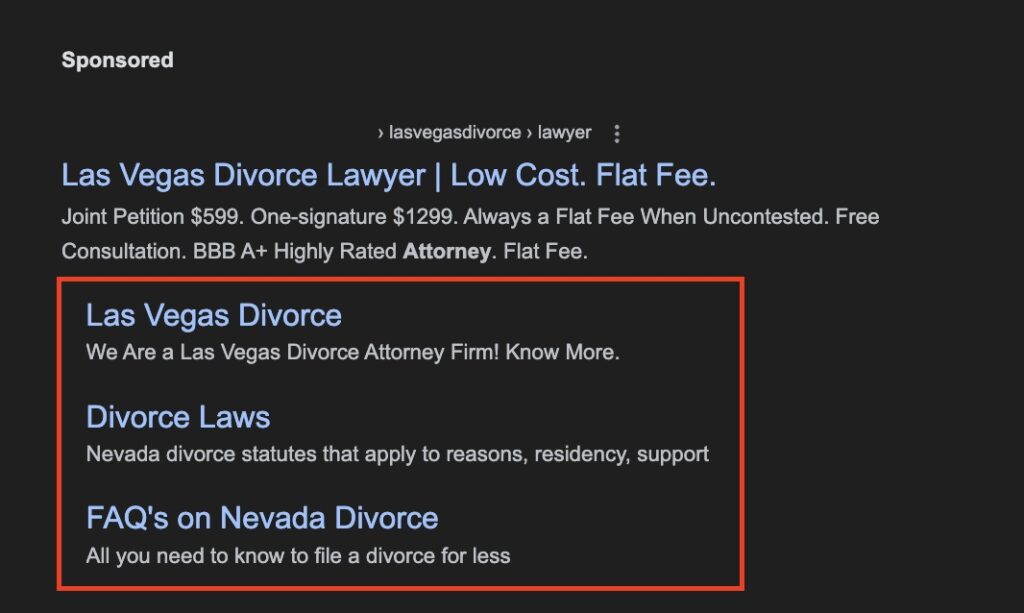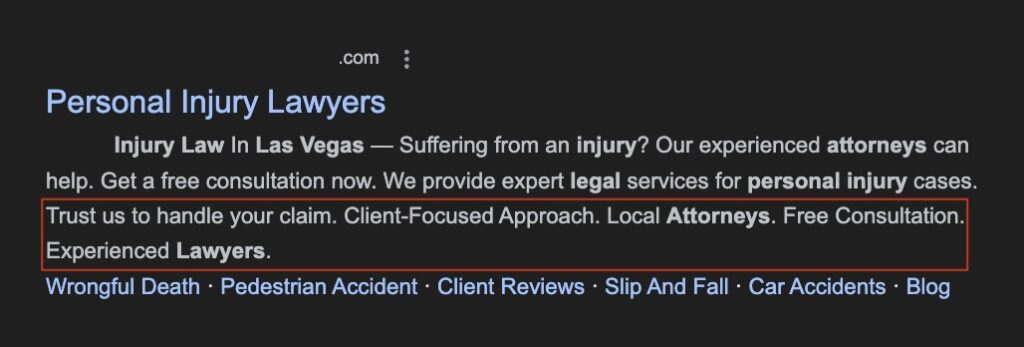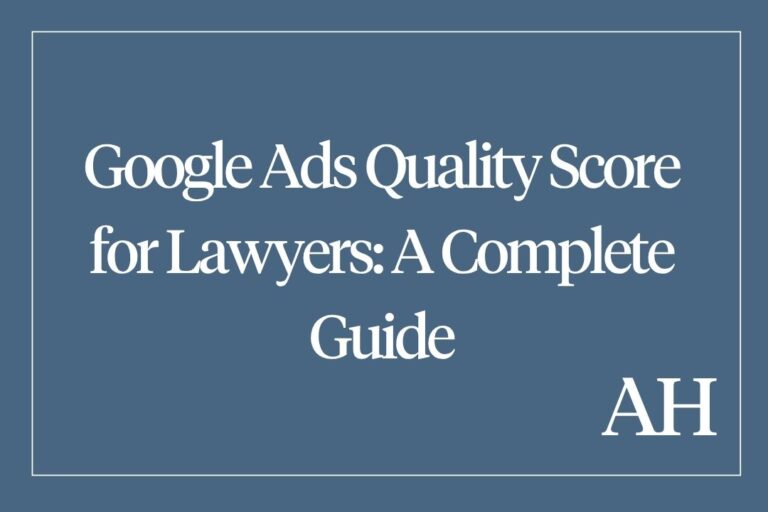Improving the click-through rate (CTR) of your Google Ads is crucial for maximizing the effectiveness of your law firm’s advertising efforts.
A higher CTR not only indicates that your ads are resonating with your audience, but it can also lead to lower costs and better ad placements.
This detailed guide will walk you through strategies to improve your law firm’s Google Ad CTR.
- For deeper insights into crafting impactful campaigns, explore our guide on effective Google Ads campaigns tailored for lawyers.
Understanding Click-Through Rate (CTR)
Definition of CTR
To start, we should first define what a click-through rate actually is and how it can be calculated.
CTR is calculated by dividing the number of clicks your ad receives by the number of times your ad is shown (impressions).
It is expressed as a percentage. For example, if your ad had 100 impressions and 5 clicks, your CTR would be 5%.
Importance of CTR
A high CTR is important because it indicates that your ad is being shown to the right audience and is actually encouraging them to take action.
It’s important to note that just because your CTR is bad or below KPI, this doesn’t mean your ads are necessarily bad. It might just mean that you are targeting the wrong audience.
It should make sense, right?
If you have an ad for a family law firm and you show it to people who do not need your services at all, they are simply not going to click.
In our experience, this is more often the case; however, this doesn’t mean that your ads are always excellent (there is typically room for improvement here as well).
Usually, there is A LOT of room for improvement for both.
Another important consideration is that an increase in CTR improves your quality score, which can lead to better ad positions, lower costs per click (CPC), and ultimately more clients out of the same advertising spend.
How to Create Compelling Ad Copy
Ad copy simply refers to the text or content in an advertisement designed to attract attention and persuade the audience to take a specific action, such as clicking on a link or making a phone call.
In general, ad copy aims to communicate the value of a product or service concisely and compellingly.
With respect to Google Ads, ad copy is crucial as it directly influences the effectiveness of the ad campaigns.
It includes the headline, description, and display URL, all of which must be crafted to match user intent, incorporate relevant keywords, and encourage users to click through to the advertiser’s website or landing page.
Headlines
Your headline is the first thing users see, so it needs to truly grab their attention.
You should use clear, concise language that highlights the main benefit or unique selling point of your service. Including numbers, questions, or keywords can make your headline more compelling.
What you’re looking to do is have your headline exactly match the intent behind the user’s search query. This isn’t very easy, given that you only have 30 characters to work with.
Here is an example to illustrate this point better:
- Let’s say a user searches ‘best car accident lawyer near me’
- And the headline for one ad says Personal Injury Lawyer – FIRM NAME
- And the headline for another ad says Best Car Accident Lawyer Near You – 98% Success Rate – Call Us Today for a Free Consultation
- It’s obvious which one will perform better.
So to effectively do this, we normally use a behavior-based approach to all Google Ads, which leverages dynamic keyword insertions to automatically create the perfect headline and description based on what is most likely to appeal to the user.
A few practical and proven formulas for creating Google Ads headlines for law firms include:
- Trusted PRACTICE AREA firm in LOCATION
- X% Success Rate (if applicable, don’t use it if it’s terrible).
- PRACTICE AREA attorney near you
- FIRM NAME
- Hundreds of Satisfied Clients (if applicable)
- Get a Free 1:1 Consultation
- Over X Years Of Experience (don’t use if it’s a small amount)
- 5 Star Rated Everywhere (this one has worked extremely well. The caveat? Most firms are not 5 star rated anywhere let alone everywhere.)
- Call Us Now (simple but proven)
Please note we normally capitalize them in ‘Title Case’, and we usually use a simple tool like Capitalize My Title to do this.
Something that might make this process easier is mapping them out on a spreadsheet and coming up with many more headlines than you need, then cutting them out.
This process does require a fair amount of time, work, and effort, but the sooner you get it right, the sooner your ads will start generating the results you desire.
You can also use artificial intelligence like ChatGPT to get ideas, though I would advise against using directly AI-generated headlines because, more often than not, they don’t perform well (it’s usually obvious they are not human). The prompt we tend to use the most is ‘Can you reword this headline five times, keeping your output to less than 30 characters’.
When creating your Google Ads you should create three different types of headlines:
- Description-based: Your firm name, your practice area. Basically, that is what you are.
- Social proof-based: anything that will positively impact your credibility. Experience, win rate, reviews, accolades, etc.
- Call to action-based: telling the user what to do next. For example, call now or request a consultation. If you offer a free consultation, I would make that abundantly clear.
Also, it is worth experimenting to see whether pinning headlines will perform better. By pinning, this refers to making it so a particular headline can only show up in one of the three positions. So if you pin a headline to position 1, it will only show up in the first position. For context, with headlines, there are three positions. This can be helpful if you want your ads to always make complete sense. For example:
- If we take the three headlines: Best Car Accident Lawyer Near You – 98% Success Rate – Call Us Today for a Free Consultation
- It probably reads better like that when compared to 98% Success Rate – Call Us Today for a Free Consultation – Best Car Accident Lawyer Near You
This is why pinning can be beneficial. That being said, just because you prefer to use Google in a certain way that doesn’t mean everyone would agree with you. This is why we often let Google do the deciding, because they have more data on everyone than we could ever imagine.
In our experience pinning usually underperforms, but in some rare cases it can outperform, so the only way to really find this out is to test and analyse the data.
Finally, I recommend giving Google as many headlines as possible to work with. There is a maximum of 15, so I recommend you provide your best 15.
The rationale behind this is that if you have 15, you are more likely to have 3 winners than if you just provide 3.
Descriptions
After you have some excellent headlines, you should then write persuasive and clear descriptions that provide more details about your law firm and your services. Something that has worked well for us is starting it with a question and then a value proposition or call-to-action:
For example, Injured in a Truck Accident? Call Us Now and Get a Free Consultation!
With descriptions, you have up to 90 characters to work with, so you can be more descriptive and sell your firm more than you can with headlines. However, being completely candid, the descriptions are rarely read in their entirety. People are lazy, and they are only getting lazier, so if they can take a shortcut, they will.
With that being said, you should still place importance on this and work on highlighting the benefits of choosing your law firm over all the others.
Here is an example: While Other Lawyers Settle For Less, We Will Fight to Get the Maximum Settlement for You.
I can’t provide you with an exact formula since different law firms’ unique selling propositions vary significantly, but you should identify your key selling points and then articulate them clearly and concisely (that is, not in legalese) so that any user can understand them.
For context, we normally try to write at about a 6th grade level, because unfortunately, a more advanced vocabulary actually does more harm than good.
Common selling points we look to highlight are:
- Experience, and more specifically, experience within a particular practice area.
- Whether the attorney works one-on-one with the client.
- If it’s a small firm, that the clients will be treated like family.
- If it’s a large firm, that the experience and resources are abundant.
Also, make sure that your description matches the intent of the user’s search query.
If you are targeting an informational keyword like ‘what does a car accident lawyer even do?’, you don’t really want to have a description or headline that says something like ‘We are the best; call us now!’.
Calls to Action (CTAs)
You should also use strong and actionable CTAs to encourage users to click on your ad. These should be in both your headline and description and have been touched on briefly previously.
Phrases like “Call Now,” “Get a Free Consultation,” or “Learn More” can work well to guide the user and prompt immediate action.
Make sure it aligns with your target audience. For example, with car accident law firms, most of the time people prefer to call, so emphasize that. On the other hand, we’ve found that with estate planning, for example, more people request information via a form than with car accident firms. So keep this in mind when creating your calls to action in both your headlines and your descriptions.
Also, as mentioned before, you want to reduce any possible friction that could exist from the call to action. For example, a free consultation has much less friction than a $500 consultation. And although this will lead to more unqualified prospects coming through, in the end, your return on investment will still be better than if you pre-qualified them with a consult fee.
Here are some results we received when we tested it:
- Free consult: 33 leads generated through the ads. Of the 33, 21 were financially qualified (able to afford a minimum of a $5,000 retainer), and 7 turned into clients that month. In the 3 months after, an additional 7 turned into clients.
- $500 Consult: 5 leads came through, and 4 turned into clients in total.
So if you had to choose between 14 and 4 clients for the same ad spend, which would you prefer?
Though I understand the thought process of charging for a consultation, there are more effective methods that enable you to have the best of both worlds. What we use are robust conversion mechanisms (an article on this is coming soon!) that allow us to have a large quantity of leads without having to force the attorney to be in consultations all day with unqualified people.
Utilizing Ad Extensions
Benefits of Ad Extensions
Ad extensions provide additional information and increase the visibility of your ads. Common ad extensions include sitelinks, callouts, structured snippets, and call extensions.
Ad extensions can seriously improve your CTR by providing more opportunities for users to click on your ad. They make your ad more informative and can increase its prominence or real estate on the search results page. So because of this, it is logical to expect that if your ad is bigger, more people will click on it. This is why you should work to implement all relevant extensions to improve the CTR of your ads.
Implementing Ad Extensions
You should use ad extensions strategically to enhance your ad copy. For example, you can use sitelinks to direct users to specific landing pages or call extensions to encourage phone calls.
My strategy with this is to add as many relevant extensions as possible.
Here is a list of the ones I would pay attention to for law firms and an image example for the ones that commonly show up:
Sitelink Extensions: Adds additional links to your ad, directing users to specific pages on your website or landing pages. I strongly recommend them, but with specific landing pages. I would not recommend them if you are taking users to your website, because the probability of that traffic converting is very low.

Callout Extensions: Add extra text to your ad to highlight specific information about your products or services. I strongly recommend these as well.

Structured Snippet Extensions: Highlights specific aspects of your products or services. Strongly recommended.
Call Extensions: This allows users to call your business directly from your ad. I recommend these, but I would say you have to be careful. Usually, clicks on call extensions will be more expensive than regular clicks, so you need to have targeted keywords for this to work.

Location Extensions: Displays your business address, phone number, and other location-related information. Sometimes recommended. I wouldn’t add it if you don’t even practice out of your office most of the time (virtual law firms). You’d be paying for people to get directions to an office you don’t even use.

Price Extensions: Display your services or products with their prices directly in your ad. This one I would recommend rarely. We sometimes highlight that we offer free consultations, but if you highlight the cost of a consult, retainer, or service, it might push people away more than help.
Promotion Extensions: Highlight specific sales and offers in your ads. This one is also rare. Occasionally, we outline that the consultation is 100% off.

Lead Form Extensions: Allows users to fill out a form directly within the ad to express interest in your products or services. This one we try to always use for relevant practice areas.
Image Extensions: Add images to your search ads to make them more visually appealing. This one we also try to always use; however, the photos we use are always of people. We are not fans of adding random stock images.

Do keep in mind that just because you add assets, this doesn’t mean they will necessarily show.
According to Google:
“Even if it’s approved, adding an asset won’t guarantee that it will show with your ad all the time. Assets show with your ad when:
- The asset (or combination of assets) is predicted to improve your ad’s performance.
- Your ad’s position and Ad Rank is high enough for assets to show.”
So because of this, we recommend that you add as many as possible and give Google as much flexibility as you can.
For detailed guidance on this topic, I recommend you visit our article on Google Ads ad extensions for lawyers.
How to Optimize the Keywords You Are Targeting
Relevant Keywords
Selecting highly relevant keywords ensures that your ads are shown to users searching for services you offer and no one else. You should conduct thorough keyword research to identify terms that potential clients are likely to use, and over time refine this based on the feedback you receive.
This is why we always set up very granular tracking mechanisms because it is important to be able to determine not only how many leads, calls, and consultations each keyword generates but also how much revenue each one generates. Because once you have this information, you can start making informed, data-driven decisions, not decisions that are based on what you ‘think’.
You can also consider changing the keyword match type. Sometimes when CTR is low, we tighten the match type, and this often helps. However, sometimes doing the opposite can help too, so take this with a grain of salt.
I would recommend that law firms start off with a phrase match, then move to exact match if needed. This is what we do most of the time.
Negative Keywords
Using negative keywords is incredibly important, not just for improving your CTR but also for having better-performing ads in general. They help filter out irrelevant traffic, ensuring that your ads are shown only to users who are likely to be interested in your services.
This can improve your CTR by a significant amount and reduce wasted ad spend. If you are targeting broad and phrase match keywords, then it is likely that with no negative keywords, you will receive a huge amount of irrelevant traffic.
The most difficult terms to block out are competitor names. There are simply too many. Right now, we have a list of around 5,000 common names to block out individual attorneys, and before we start working with a client, we create a list of every law firm in their city at first and then state later on. That way, we reduce the chances of paying for a user who wants to work with a competitor as much as we possibly can.
Do note that on some occasions, it makes sense to actively target competitor names, but for most law firms, I would say you shouldn’t even consider it.
For more on using negative keywords, see our article on using negative keywords in Google Ads for lawyers.
Dynamic Keyword Insertion
Dynamic keyword insertion makes your ads more relevant by automatically inserting the keyword that was prompted by the user’s search query into your ad copy. This is super powerful, however, only if done correctly.
So, for example, if you are targeting the keyword “car accident lawyer” and someone searches for auto accident lawyer and your ad shows up, it will put the keyword in the headline and/or description.
This can make the ad more relevant and, therefore, increase the CTR.
For this, we use a behavior-based approach to really dial this in, and it works incredibly well.
If you want to learn more, you can read about dynamic keyword insertion for Google Ads lawyers.
How to Target the Right Audience
Demographic Targeting
On top of targeting the right people by choosing the right keywords, you also want to refine your audience by using demographic data to target specific age groups, genders, parental status, and household incomes.
This ensures that your ads are shown to the most relevant users at all times.
For example, if you are an estate planning and asset protection firm and you want to target more affluent individuals, you should update this in your targeting to not waste your advertising spend on people that can’t even use your services. You should also not be showing your ads to individuals that are very young and unlikely to be serious potential clients for your services.
For search ads, the following audience segments apply:
- Affinity segments: target users according to their passions, habits, and interests.
- Example: Reach users who frequently read legal blogs, follow news about court cases, or participate in forums about legal advice.
- Detailed demographics: target users based on significant life characteristics.
- Example: Advertise to newly married couples who might need legal assistance with prenuptial agreements or target new homeowners who might need help with real estate contracts.
- In-market: target users showing recent purchase intentions.
- Example: Reach individuals actively searching for personal injury lawyers due to recent accidents or target users looking for estate planning services by visiting related legal service websites.
- Your data segments: Reach users who have previously interacted with your business.
- Example: Retarget visitors who have filled out a contact form on your law firm’s website but haven’t scheduled a consultation, or re-engage previous clients with updates on new legal services and special offers.
Do note that most of the time we use ‘observation only’ for audience segments. This is because we want to give Google a degree of flexibility, especially at the start.
Geographic Targeting
Your ads have to target specific locations where your services are available. It might sound obvious, but it is not super easy to execute in practice. This is particularly important for law firms that are unable to serve clients in specific regions.
You should use location targeting to focus your ad spend on areas where you can attract clients and only there.
You must also ensure that in the location targeting settings, only presence is selected and not presence or interest. This is incredibly important.
If presence or interest is selected, the following is possible:
- Someone in Ahmedabad, India, searches ‘car accident lawyer New York’
- Your ad shows up because you are in New York, and the user is ‘interested’ in New York.
- They click on your ad.
- This costs you money.
- From which you get absolutely nothing.

It is also important to note that the inverse can actually happen:
- Someone in New York searches ‘car accident lawyer Columbus, Ohio.
- Your ad shows up because you are in New York, and the user is ‘present’ in New York.
- They click on your ad.
- This costs you money.
- From which you get absolutely nothing.

What we normally do is have a list of every single city in the U.S. and add this list to the negative keywords (obviously removing the cities we are trying to target).
This makes it nearly impossible for the second situation to happen to our clients. So what this does is improve our CTR and also lead to less wasted ad spend, which work together to significantly improve the results we get for our clients.
Device Targeting
You should also look to optimize your ads for different devices. Once you have performance data to see which devices (desktop, mobile, or tablet) are driving the most clicks and conversions, you can adjust your bids accordingly.
So, for example, if mobile searches lead to the most revenue, then you might want to increase how much you are bidding on mobile or even create a mobile-only campaign.
This is common for personal injury, but desktop dominance can be seen in certain locations, which is why we rarely completely exclude desktop.
I would recommend only making this decision with data and not at the start of your campaign, because sometimes these things are difficult, if not impossible, to predict.
For more insights, visit our article on geotargeting in Google Ads for lawyers.
How to Improve Ad Relevance
Quality Score
Quality Score is a metric that Google uses to determine the relevance and quality of your ads. It impacts your ad rank and CPC.
A higher Quality Score can lead to better ad positions and lower costs.
So if you have a poor Quality Score you might show up second or third, which will lead to a lower CTR as most people typically click on the first result only.
The following two sections outline how to improve two out of the three quality score components. Not that the one that is not discussed in this section is ‘expected clickthrough rate (CTR)’ because this was covered in detail in the previous sections.
Improving quality score is not a simple process, so I recommend you read the article we wrote about Google Ads quality score for lawyers.
Ad Relevance
To ensure you have the best possible ad relevance, make sure that your ad copy is closely related to the keywords you are targeting. A common mistake that can happen with this is having too many keywords in a single ad group.
I would recommend you split up all of your ad groups into the specific practice areas you work with.
For example, for a personal injury law firm, it is not enough to create an ad group for all motor vehicle accidents. You should separate it more granularly, like this:
- Car accidents
- Truck accidents
- Drink-driving accidents
- Rideshare accidents
- Motorbike accidents
- Pedestrian accidents
- Public transport accidents
This, combined with only choosing extremely relevant keywords, will really help improve your ad relevance and, hence, your Quality Score, CTR, and overall results.
Landing Page Experience
You should align your landing page content with your ad copy as much as you possibly can. Building on the previous example, you should have different targeted landing pages for each ad group.
You should make sure that the landing page is relevant to the user’s search query. So, for example, if the search query is ‘car accident lawyer near me’ all of the landing page content should be tailored to car accidents, not just generic personal injury copy.
It should also provide a good user experience. It should be easy to use, not complicated or difficult to fulfill the calls to action. If you want to take it to the next level, I would even recommend creating a separate one for mobile and desktop. That way, they can be incredibly tailored and well designed. We often do this and usually find that it makes a very nice difference in the results we achieve.
For more landing page optimization tips, see best practices for Google Ads landing pages for lawyers.
A/B Testing and Continuous Optimization
A/B Testing
Now, once you have some data on your account, you should look to run A/B tests to compare different ad variations and identify the best-performing ads.
You should look to test different headlines, descriptions, CTAs, and ad extensions to see what resonates most with your audience.
You never want to stop testing, because the more experiments that you run, the more data that you end up with, which will over time help you create the strongest campaign possible.
Even if the variable you were testing did not improve the results you received, you still end up with information as to what not to do, so you can pivot and try something else moving forward.
Performance Analysis
On top of constant A/B testing, you should be constantly analyzing your ad performance data to identify trends and areas for improvement. Without data, any decision you make is purely emotional, and this type of decision-making does not serve you well in performance advertising.
You should regularly monitor metrics such as CTR, conversion rate, and CPC to evaluate the effectiveness of your ads. Once you have been running them for some time and have some baselines, you can truly understand what your KPIs should be. I personally wouldn’t listen to someone telling you to aim for a specific CTR or a specific CPC because the reality is that it can vary so much, and these metrics should not be your primary focus.
Your North Star should be the return on advertising spend for which you should have minimum acceptable benchmarks, and then you should work to see what the minimum CTR, maximum CPC, and minimum CVR would lead to you achieving that return.
Then, once you have more information, you should regularly update and refine your ads based on performance data and market changes. With performance advertising, the market moves extremely fast, so continuous improvement ensures that your ads remain relevant and effective.
For more on A/B testing, visit A/B testing in Google Ads for lawyers.
Monitoring and Adjusting Bids
Bid Strategies
Finally, you should choose the right bid strategy for your goals. Manual CPC bidding allows you to have an extreme level of control over individual keyword bids, while automated bidding strategies can optimize bids based on your desired outcomes, such as maximizing clicks or conversions.
Typically, we start campaigns on fresh accounts with either maximize clicks or manual CPC, and then once the account has some data, we have found maximize conversions works extremely well.
But you should take this with a grain of salt, because this varies significantly. It is not a plug-and-play strategy. The best approach for your practice area and location can depend on a wide variety of factors.
Adjusting Bids
On top of choosing the right big strategy, you should also adjust your bids based on the performance data you receive.
You should increase bids for high-performing keywords and decrease bids for underperforming ones, and although this seems simple, it is often overlooked (probably because it takes a lot of work in the long term). Regular bid adjustments help optimize your ad spend and improve your ad’s CTR.
Conclusion
Hopefully this guide answered all of the questions you had regarding how to improve your law firm’s Google Ad click-through rate. Hopefully you learned something new, and I am certain that if you implement some of the insights shared in this guide, your campaigns will perform better. Optimizing your CTR is essential for maximizing the effectiveness of your advertising efforts.
By crafting ad copy that actually converts, utilizing ad extensions appropriately and abundantly, optimizing your keyword selection, targeting the right audience, improving ad relevance and position, and continuously testing and refining your ads, you can achieve a higher CTR, which means more leads and ultimately more revenue.
If you found this helpful, I would recommend you subscribe to our newsletter for weekly updates and valuable resources.
Also, if you’re interested in working with us, fill out the form below, and we’ll contact you soon!
Thank you for reading 🙂



